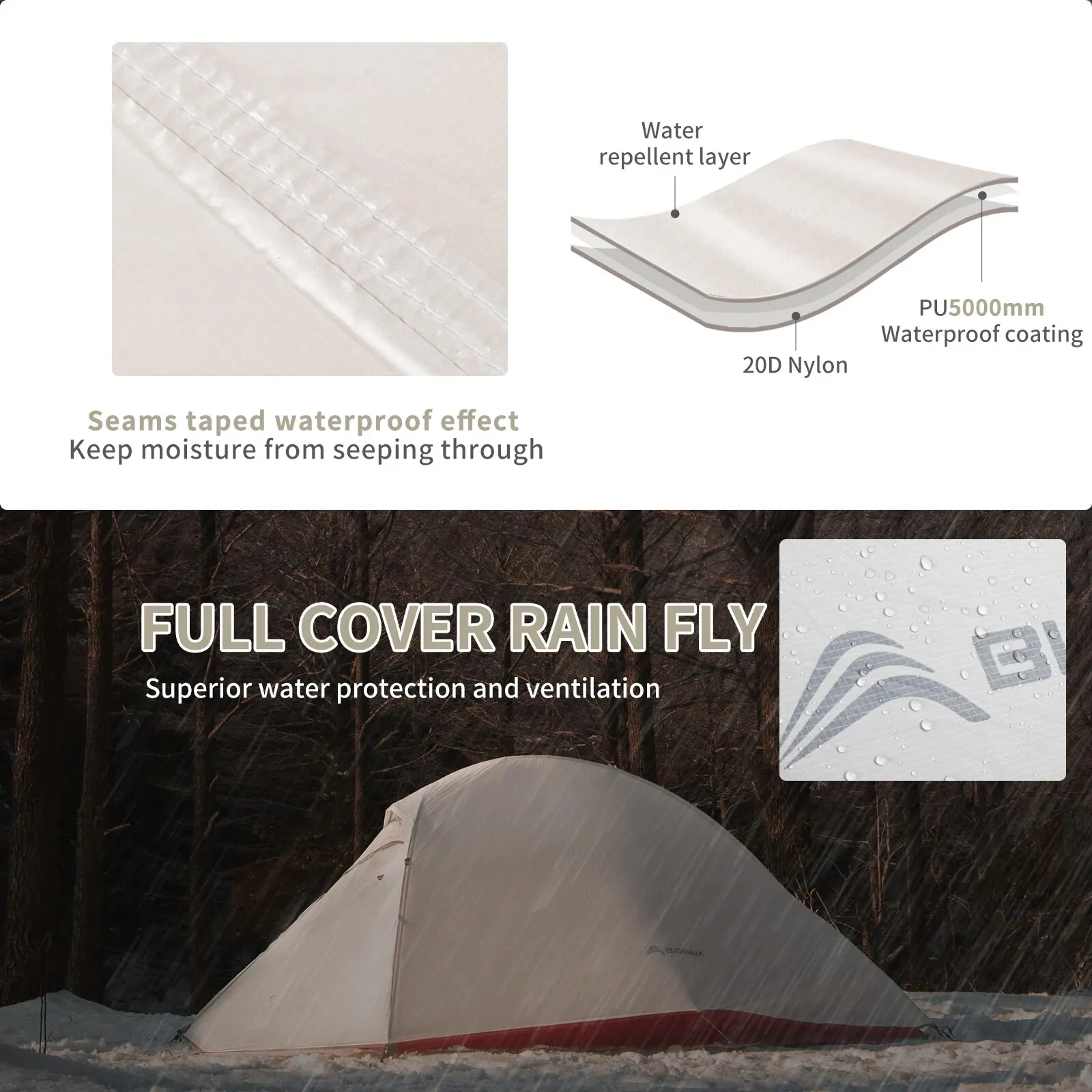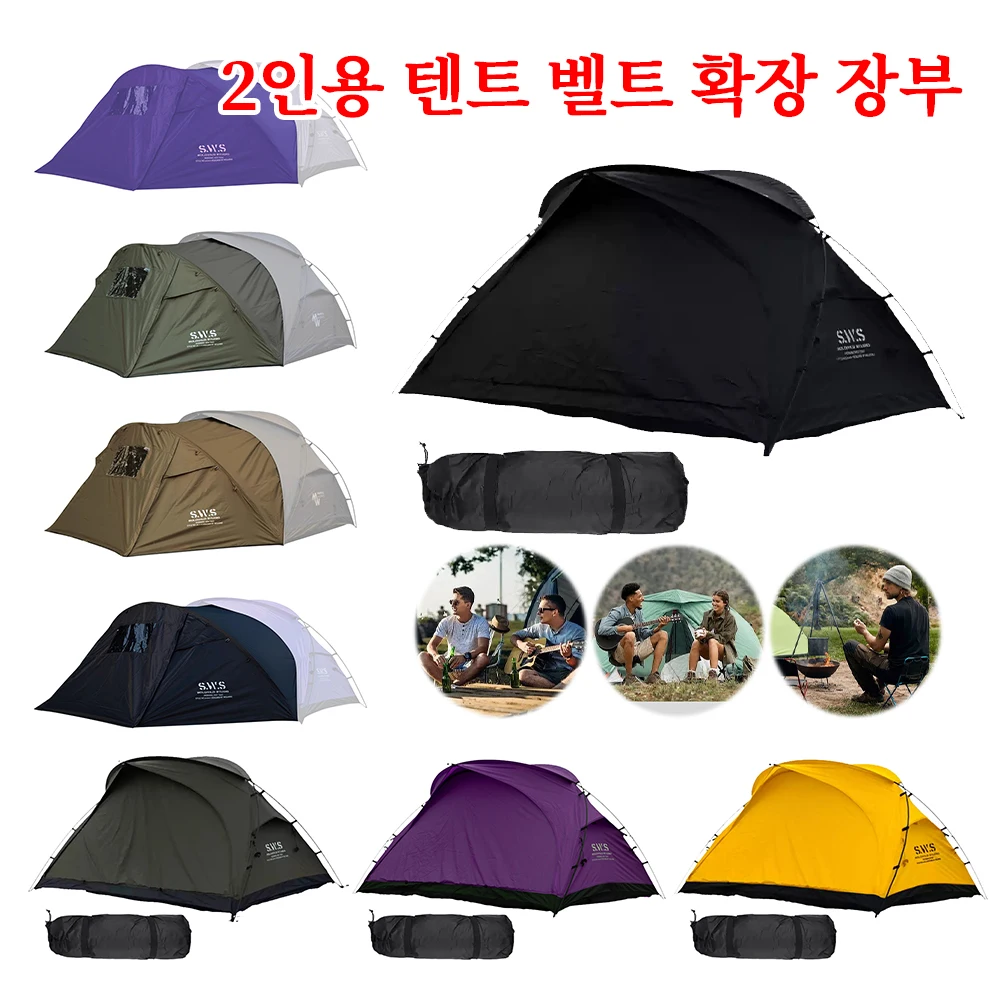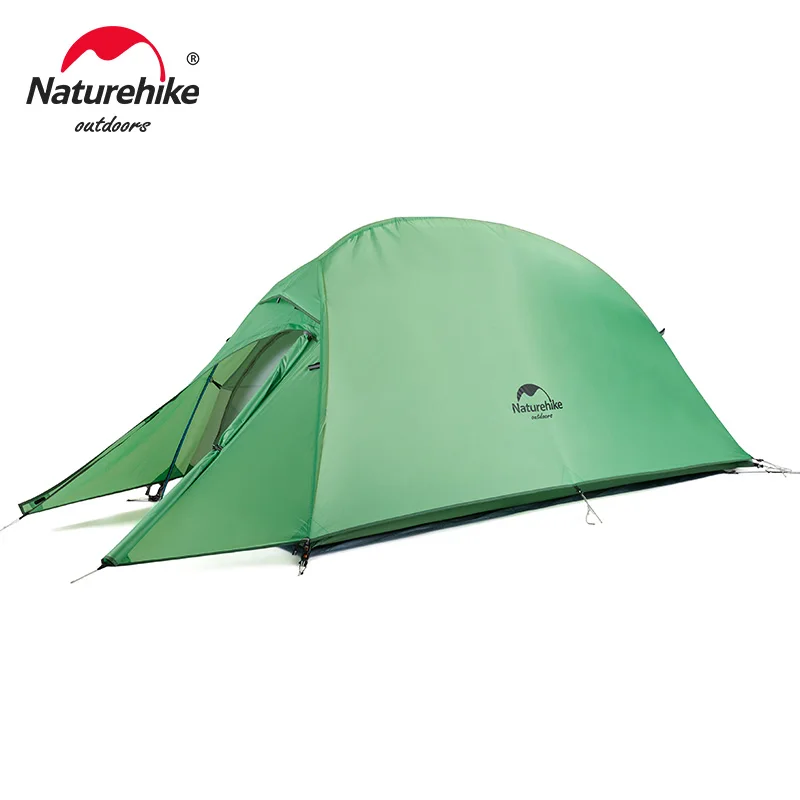Understanding Lightweight Trekking Tents: The Foundations
When preparing for a trek, the weight of your gear can make all the difference between an enjoyable journey and a grueling ordeal. In the world of backpacking, a “lightweight” tent typically weighs under 3-4 pounds (1.8kg) – significantly less than standard camping tents that often weigh 5-8 pounds or more.
Tent weight is crucial because it forms a significant portion of your overall pack weight. Many experienced backpackers follow the “rule of thirds” for gear distribution: shelter, sleeping system, and everything else should each comprise about one-third of your total pack weight. Reducing tent weight immediately lightens your overall load, allowing for greater comfort and efficiency on the trail.
The challenge lies in finding the perfect balance between weight reduction and necessary functionality. Unlike ultralight shelters that might sacrifice features or durability for minimal weight, or regular camping tents that prioritize comfort and convenience over portability, lightweight trekking tents aim for the sweet spot between these extremes.
Achieving this balance involves thoughtful design and material selection across several key areas. Comprehensive tent selection information requires understanding these fundamental elements that contribute to a tent’s overall weight profile and performance capabilities.
Trekkers who understand why tent weight matters for long treks can make more informed decisions about what to prioritize in their shelter systems. Let’s explore the essential components that make a tent truly lightweight while maintaining the protection and comfort needed for successful trekking adventures.
Material Science: The Primary Weight Determiner
Advanced Fabrics and Their Weight-to-Strength Ratio
The single most important factor in creating a lightweight trekking tent is fabric selection. Modern tent materials represent remarkable achievements in textile engineering, offering impressive strength-to-weight ratios that weren’t possible even a decade ago.
Nylon variants dominate the lightweight tent market:
* Ripstop Nylon: Features a reinforced grid pattern that prevents tears from spreading, offering increased durability despite thinner material.
* Silnylon: Nylon impregnated with silicone, creating a waterproof barrier that’s lighter than traditional coatings while increasing fabric strength by up to 20%.
Polyester fabrics offer their own advantages in certain conditions. While slightly heavier than comparable nylon, polyester maintains its tension when wet (unlike nylon, which can stretch and sag), and offers superior UV resistance—important considerations for extended treks.
At the premium end of the spectrum, Dyneema Composite Fabric (DCF), formerly known as Cuben Fiber, represents the pinnacle of ultralight tent materials. A 0.51 oz/sqyd DCF fabric can be up to 15 times stronger than steel by weight. A two-person tent using DCF might weigh just 1.5 pounds (680g) compared to a similar silnylon tent weighing 2.5 pounds (1.1kg).
The thickness of these materials, measured in denier (D), directly impacts weight. Ultralight tents often use 10-20D fabrics for the canopy, compared to 40-70D materials in standard camping tents. This difference alone can reduce a tent’s weight by 30-40%, though with corresponding reductions in puncture resistance.
Understanding specific tent materials and their properties helps trekkers make informed choices about the durability-to-weight trade-offs that best suit their needs. Our selection of lightweight backpacking tents demonstrates how modern materials can maintain performance while dramatically reducing weight.
Decoding Fabric Technical Specifications
Understanding technical fabric specifications helps trekkers evaluate the true performance potential of lightweight tents:
| Specification | Description | Lightweight Tent Range | Impact on Performance |
|---|---|---|---|
| Denier (D) | Thickness of fabric fibers | 7D-30D | Lower numbers = lighter weight but less durable |
| Thread Count | Number of threads per square inch | 280T-330T | Higher count = stronger but potentially heavier |
| Hydrostatic Head | Water pressure resistance (mm) | 1,200-3,000mm | Higher rating = better waterproofing but often heavier coating |
| Tear Strength | Resistance to tearing (measured in N) | 8N-15N | Higher strength = more durability with minimal weight impact |
The denier rating deserves special attention as it most directly correlates with weight. A 10D flysheet weighs roughly half as much as a 20D flysheet of the same dimensions. However, that weight saving comes with reduced puncture and abrasion resistance. For side panels and areas less prone to abrasion, 10-15D materials can offer excellent weight savings with acceptable durability. Floor materials typically use higher denier ratings (20-30D) to withstand ground contact.
Waterproof coatings also impact weight. Silicone coatings (particularly when applied to both sides of the fabric—“sil/sil”) offer the best strength-to-weight ratio but can’t be seam-taped. Polyurethane (PU) coatings allow for seam taping but add slightly more weight and provide less strength enhancement. Many ultralight backpacking tents use strategic combinations of these coatings to optimize both weight and weather protection.
Structural Engineering: Pole Systems and Architecture
Innovative Pole Materials and Designs
Tent poles represent the second major contributor to overall tent weight. The material, diameter, and design of pole systems dramatically impact both weight and stability.
Aluminum alloy poles currently dominate the lightweight tent market, with premium tents featuring specialized alloys like DAC Featherlite NSL. These high-end aluminum poles typically weigh 25-30% less than standard aluminum poles while maintaining similar strength characteristics. A complete aluminum pole set for a lightweight two-person tent typically weighs between 9-14 ounces (255-396g).
Carbon fiber pole options push weight reduction even further, offering up to 30% weight savings compared to aluminum equivalents. A carbon fiber pole set might weigh just 7-10 ounces (198-283g). However, this weight savings comes with trade-offs: carbon fiber poles are generally more expensive and, while strong under normal conditions, can shatter rather than bend when subjected to extreme stress.
Beyond material selection, pole architecture makes a substantial difference:
* Hub-based designs reduce the total pole length needed
* Minimalist single-pole designs supported by guylines
* Strategic pole crossings that maximize interior space with fewer poles
* Variable diameter poles that place stronger, thicker sections where structural demands are highest
The best freestanding backpacking tents demonstrate how innovative pole systems can create surprisingly stable and spacious shelters despite minimal weight. These designs carefully balance the competing demands of structural integrity, interior volume, and weight reduction.

Trekking Pole Integration and Specialized Support Systems
One of the most effective weight-saving strategies eliminates dedicated tent poles altogether by repurposing the trekking poles many hikers already carry. This approach can reduce a tent’s weight by 8-14 ounces (227-396g)—a significant saving when every ounce matters.
Trekking pole tents use various attachment mechanisms:
* Direct insertion into reinforced corner pockets
* Adjustable attachments that accommodate different pole lengths
* Hybrid designs that combine trekking poles with minimal dedicated pole sections
* Specialized connectors that join two trekking poles for greater height or stability
These designs also rely on sophisticated guyline systems that create tension throughout the structure. While effective, this approach requires more time for setup and typically demands more precise site selection than freestanding designs.
The main limitations include compatibility requirements with specific trekking pole types, reduced interior volume compared to dome designs, and increased vulnerability to wind from certain directions. However, for many long-distance trekkers, these trade-offs are well worth the significant weight savings.
Our comprehensive guide to trekking pole tents explores these considerations in detail, helping trekkers determine if this ultralight approach matches their needs. Many experienced long-distance hikers select trekking pole backpacking tents for minimizing carried weight while maintaining essential protection.
Architectural Efficiency: Design Principles for Weight Reduction
Single-Wall vs. Double-Wall Construction
The fundamental architectural choice between single-wall and double-wall construction significantly impacts a tent’s weight, weather resistance, and comfort.
Double-wall tents feature separate inner tent (typically mostly mesh) and rainfly components. This design excels at moisture management by allowing condensation to form on the rainfly while keeping the inner tent dry. However, the additional material and zippers add weight—typically 20-40% more than comparable single-wall designs.
Single-wall tents combine these layers into one integrated structure, eliminating duplicate materials and substantially reducing weight. A single-wall two-person tent might weigh just 1.5-2.5 pounds (680-1134g) compared to a similar double-wall model weighing 2.5-3.5 pounds (1134-1587g).
However, single-wall designs face significant condensation management challenges. Without separation between the inner tent and rainfly, moisture from breathing and body heat more readily condenses on interior surfaces. Manufacturers address this issue through:
* Strategic ventilation placement
* Air circulation channels
* Specialized fabric treatments
* Hybrid designs with partial double-wall sections in key areas
Long-distance hikers often prefer single-wall or hybrid designs for weight savings, accepting more active condensation management as a reasonable trade-off. For shorter trips or humid environments, the moisture management benefits of double-wall designs might outweigh their weight penalty.
Strategic Feature Minimalism
Lightweight tent design often involves thoughtful reduction of features that add weight without proportional functional benefits.
Door configurations represent a prime example. A single door and vestibule design can save 4-8 ounces (113-227g) compared to a two-door design. While slightly less convenient for multiple occupants, this weight saving might be well worth the minor inconvenience for weight-conscious trekkers.
Other common minimalist approaches include:
* Reduced number of interior pockets (saving 1-2 ounces)
* Simplified ventilation (fewer zippers and adjusters)
* Shorter zipper lengths or water-resistant zippers that don’t require protective flaps
* Lower-profile bathtub floors (using less material while still providing splash protection)
* Fewer attachment points and guylines (though critical ones remain)
These minimalist approaches don’t simply eliminate features—they carefully evaluate the utility-to-weight ratio of each element. The best compact backpacking tents maintain high functionality while eliminating unnecessary weight through thoughtful design choices.

Floor Plan and Interior Efficiency
Tent floor design and interior architecture offer significant opportunities for weight reduction through geometrical optimization.
Tapered designs narrow the foot end of the tent, reducing fabric requirements by up to 15% compared to rectangular floor plans. This tapering follows the natural shape of the human body, which needs less space at the feet than at the shoulders and head. While this reduces the overall floor area, it removes space that would typically go unused.
Vertical wall designs have given way to more angled walls in lightweight tents, requiring less material and fewer poles while still creating sufficient interior volume. Strategic pole placement creates steeper walls only where needed most—typically near the head area where occupants sit up.
The most efficient designs carefully position the peak height to maximize usable interior volume. By placing the highest point slightly forward of center, the tent creates adequate headroom for sitting while allowing more aggressive tapering toward the foot end.
Many lightweight tents also employ asymmetrical designs that allocate space based on typical usage patterns rather than geometric symmetry. These tents might provide more space on one side for gear storage or more headroom on one end for sitting.
Understanding the essential features of trekking tents helps hikers evaluate which interior space trade-offs will work for their specific needs and sleeping preferences.
Lightweight Backpacking Tent, Ultralight Backpacking Tent, Ultralight Bivy Tent
Ultralight Single Person Camping Tent with Aluminum Poles for 3-Season Backpacking Waterproof DesignPrice range: $94.88 through $326.82 Select options This product has multiple variants. The options may be chosen on the product pageLightweight Backpacking Tent, Ultralight Backpacking Tent, Waterproof Backpacking Tent
$391.05 Select options This product has multiple variants. The options may be chosen on the product pageCompact Backpacking Tent, Lightweight Backpacking Tent, Waterproof Camping Tent
$335.52 Select options This product has multiple variants. The options may be chosen on the product pageUltralight Backpacking Tent, Ultralight Dome Tent, Winter Camping Tent
Price range: $369.63 through $370.07 Select options This product has multiple variants. The options may be chosen on the product pageBackpacking Tent with Vestibule, Freestanding Backpacking Tent, Lightweight Backpacking Tent
Price range: $446.89 through $447.22 Select options This product has multiple variants. The options may be chosen on the product pageBackpacking Tent with Vestibule, Trekking Pole Backpacking Tent, Waterproof Camping Tent
Price range: $271.99 through $519.52 Select options This product has multiple variants. The options may be chosen on the product page
Critical Considerations: The Performance Equation
Weather Resistance and Durability Trade-offs
Weight reduction inevitably involves certain performance trade-offs, particularly regarding weather resilience and long-term durability.
Lightweight tents generally offer less resistance to extreme conditions than their heavier counterparts. With fewer poles, thinner materials, and often more minimalist designs, their performance envelope has narrower margins. However, quality lightweight tents aren’t inherently unsafe—they simply require more attention to proper setup and site selection.
Wind performance presents the most significant challenge for ultralight designs. With fewer poles and lighter materials, these tents rely more heavily on proper staking and guyline tensioning. A tent that weighs half as much typically offers less margin for error in severe weather. Understanding what makes a tent windproof helps trekkers compensate for these limitations through improved technique.
Durability considerations extend beyond the trip itself to the tent’s overall lifespan. Lower denier fabrics resist abrasion less effectively, potentially shortening the tent’s useful life with regular use. Many trekkers compensate by carrying groundsheets or being more selective about tent sites.
Despite these trade-offs, modern waterproof backpacking tents demonstrate that lightweight designs can still provide reliable protection in challenging conditions. The key lies in understanding the tent’s limitations and adjusting expectations and techniques accordingly.
Seasonal Adaptability and Environmental Factors
Lightweight tents perform differently across varying environments and seasons, requiring careful matching of tent characteristics to intended use conditions.
Most lightweight trekking tents are designed primarily for three-season use (spring, summer, fall), with limited capacity for winter conditions. Extended season models add reinforcements and more robust pole structures to handle light snow loads, but true four-season capability generally requires accepting a weight penalty.
Environmental factors to consider when selecting lightweight tent designs include:
Altitude: Higher elevations bring stronger UV exposure (degrading lighter fabrics faster) and potentially stronger winds (challenging minimalist pole structures).
Humidity: High-humidity environments increase condensation concerns, especially in single-wall designs, while dry environments may allow for even lighter rain protection.
Temperature fluctuations: Larger daily temperature swings create more condensation challenges for lightweight designs with less ventilation.
Ground conditions: Rocky or abrasive surfaces may demand higher denier floor materials despite the weight penalty.
The comprehensive guide for multi-day trek tents helps match specific environmental challenges with appropriate lightweight tent characteristics. No single tent excels in all environments, making this matching process essential for optimizing the weight-to-protection ratio.

Advanced Perspectives: Beyond Basic Weight Reduction
Is Ultralight Always Right? Analyzing Your Trekking Style
While reducing pack weight offers clear benefits, the “lightest possible” option isn’t automatically the best choice for every trekker. Consider these questions when evaluating how light to go:
- How sensitive is your back/joints to carrying weight over long distances?
- Do you typically camp in protected or exposed sites?
- How important is sleep quality to your overall trekking experience?
- Are you comfortable with more careful handling of delicate materials?
- How frequently do you encounter sustained adverse weather?
For weekend trips in mild conditions, ultralight options below 2 pounds (907g) might offer the perfect balance. For extended backcountry journeys with variable weather, a slightly heavier but more robust tent (2.5-3.5 pounds/1.1-1.6kg) could provide better overall value despite the weight penalty.
Many trekkers evolve their preferences over time, often starting with more forgiving (slightly heavier) designs before developing the skills and experience to use ultralight gear effectively. Understanding whether a 3kg backpacking tent is too heavy for your specific needs requires honest assessment of your priorities and trekking conditions.
How Do Materials and Design Affect Tent Lifespan?
The long-term value equation of lightweight tents depends significantly on their durability relative to heavier alternatives. While lightweight tents generally have shorter lifespans than their heavier counterparts, proper care can substantially narrow this gap.
Ultralight fabrics (particularly those under 15D) typically show wear more quickly and may develop tears or abrasion points after 100-200 nights of use. In contrast, more robust 30-50D fabrics might last 300-500 nights under similar conditions.
This durability difference affects the true cost of ownership. A $600 ultralight tent lasting 150 nights costs $4 per night of use, while a $400 standard tent lasting 300 nights costs $1.33 per night—a significant difference for frequent trekkers.
Maximizing lightweight tent lifespan requires:
* Careful site selection to avoid abrasive surfaces
* Diligent storage completely dry and away from UV exposure
* Gentle handling, particularly of zippers and thin fabrics
* Prompt repair of minor damage before it spreads
The benefits of lightweight tents for extended hikes can outweigh these durability concerns, particularly when the physical comfort of carrying less weight allows for more enjoyable and sustainable trekking experiences over time.
At Explore Elements, we carefully balance these considerations in our tent selection, ensuring our lightweight options deliver the performance trekkers need without unnecessary compromises to durability or weather protection. The perfect lightweight tent represents balance—removing every unnecessary gram while retaining everything essential for comfort, protection, and longevity on the trail.







